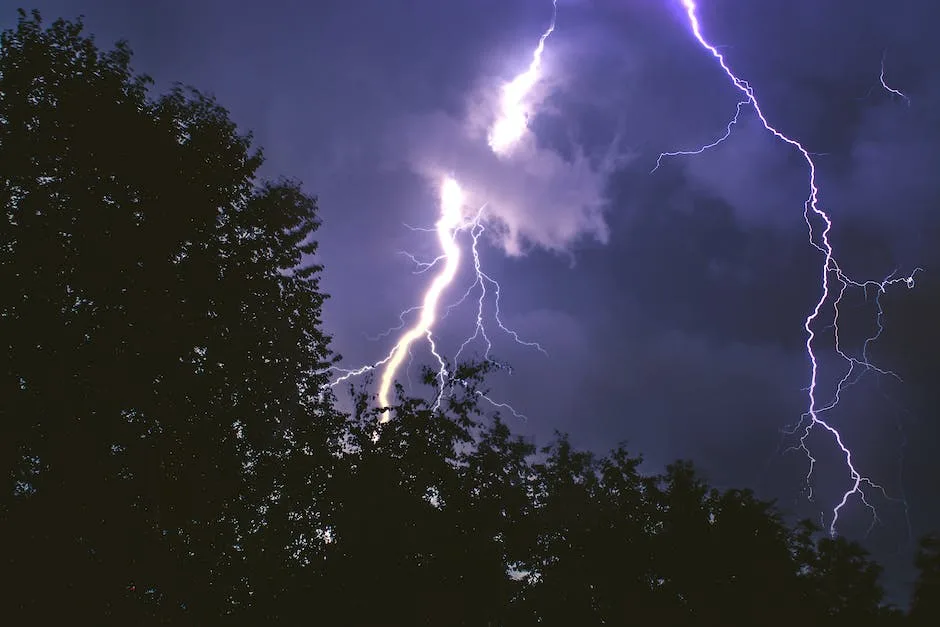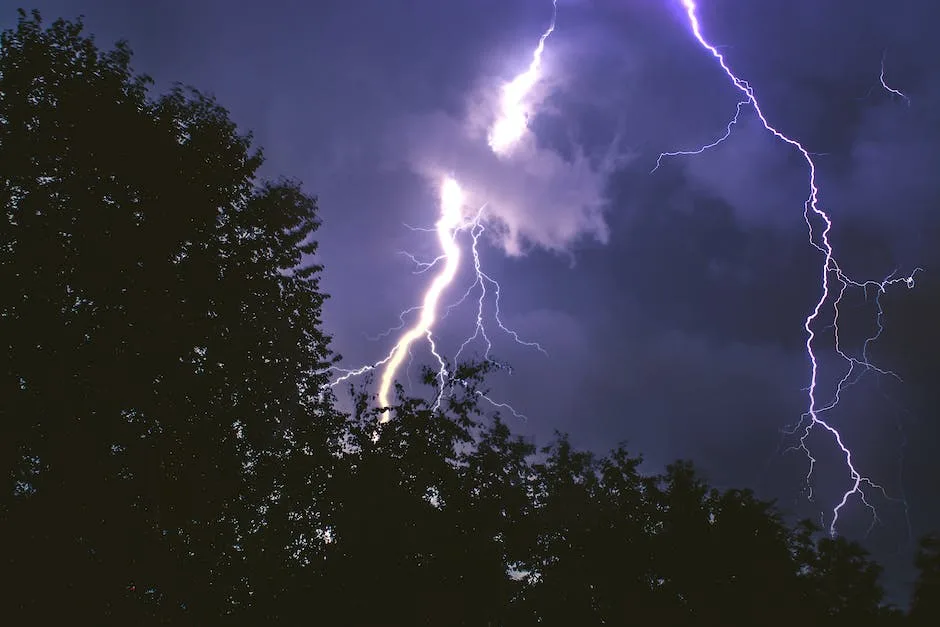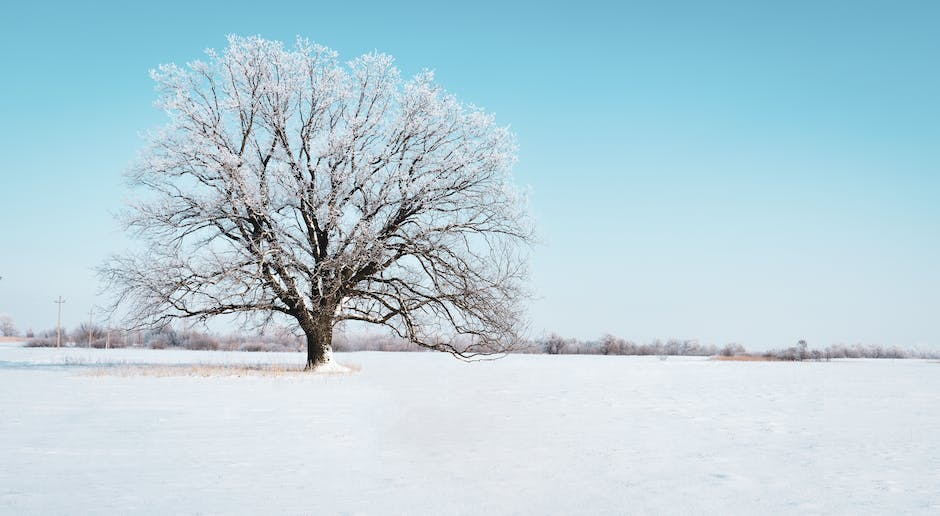Trees are often struck by lightning during thunderstorms, and while this typically doesn’t kill the tree outright, it can cause serious damage. An oak tree can survive a lightning strike if the damage isn’t too severe, but it will likely be scarred for life. If you see a tree that’s been struck by lightning, it’s best to leave it alone and let nature take its course.
It is possible for an oak tree to survive a lightning strike, but it is not guaranteed. The tree may be damaged or killed by the strike, depending on the severity of the strike.
What happens when a oak tree is struck by lightning?
When a tree is struck by lightning, the electrical current passes from the trunk of the tree through the roots and dissipates in the ground. Major root damage from electricity can cause the tree to decline and die without significant aboveground damage. If the tree is in leaf, the leaves wilt and the tree will probably die within a few days.
If you have an oak tree that has been struck by lightning, there are some things you can do to try to save it. First, if the damage is not too severe, you can prune away any broken or damaged branches. This will help to encourage new growth. You can also apply a tree sealant to the tree to help protect it from further damage. If the damage is more severe, you may need to consult a professional tree service to see if the tree can be saved.
Will a tree live after being struck by lightning
Lightning damage to trees is instantaneous and can be deadly. When lightning strikes a tree, it turns the liquids inside the tree to gas instantly and the tree bark explodes. Some 50% of trees hit by lightning die immediately. Others become weakened and susceptible to disease.
The roots of oak trees go deep into the ground, which makes them good conductors of electricity. Additionally, the hollow water-filled cells in the trunk of the tree act as a buffer against the electrical current, making the tree less likely to be damaged by lightning strikes.
Can oak trees withstand storms?
Most live oak trees are sturdy thanks to their thick trunks and extensive roots. The sand live oak is one of the sturdiest In addition to severe winds, sand live oaks can tolerate salty soils, which makes them perfect for hurricane-prone areas on the coast.
Oaks are by far the most likely trees to be hit by lightning, according to research. Other trees that seem to be common targets include elm, ash, yellow poplar, and pine. Everyone is aware of the safety tip of not standing under a tree during a thunderstorm, based on the likelihood that the tallest objects are most likely to be struck by lightning.
Can lightning split a tree in half?
Lightning is one of the most dangerous things that can happen to a tree. The heat and electric sparks can easily start a fire, and the force of the strike can easily split a tree in half. If you see a tree that has been struck by lightning, it is best to stay away from it and call a professional to help assess the damage.
Trees do not heal like humans. If a tree is wounded by lightning, it will not heal. Instead, the tree will try to seal the wound off from the healthy parts. This is a natural process and the best thing you can do for your tree, in most cases, is to allow it to happen.
Why tall tree is not safe during lightning
Trees are not good conductors of electricity, so when you go under a tree during a thunderstorm, the current from the lightning will pass through your body. The human body is a good conductor of electricity, so you could be seriously injured or killed if you are struck by lightning while under a tree. It is best to avoid trees during a thunderstorm.
A tree that has been hit by lightning can either be very dry or very wet. If the tree is still fresh and full of water, it won’t burn. However, if you leave a tree that has been hit by lightning some time to dry out, then it will burn normally.
How long does a tree stay in shock?
It’s important to be patient when transplanting trees – it can often take a few years for them to fully recover. In most cases, it takes a year or so for trees to shake off transplant shock, but occasionally it can even take up to 5 years. Don’t give up on your trees if they’re still showing stress symptoms after a few years – they may just need a little more time to adjust to their new home.
Anytime a tree is struck by lightning, the tree can bend and then bounce back. This means that the bark is cracked. This sometimes will split a tree open and sometimes it will blow the bark back from a tree and break its branches. When there is more than one shock wave, you may notice more splitting.
Why do oak trees dominate
The oaks’ success was due in part to their rapid southward migration. This enabled them to quickly become established in new territory and diversify more than any other deciduous tree. Davis (1983) provides an in-depth look at this key aspect of the oaks’ success.
A lightning protection system is a great way to protect your trees from being struck by lightning. The system basically consists of a copper cable that runs along the tree, intercepting a lightning bolt and guiding it to the ground instead of striking the tree. This can help to minimize the damage that your trees sustain from lightning strikes.
How flammable are oak trees?
Oak leaves are more flammable than other hardwoods because they tend to be drier (more xerophytic) and they curl more than other hardwoods. This puts the fire up off the ground, making it capable of spreading more effectively. Thus, oak leaves are more flammable and more capable of “carrying” a fire.
The oak tree is one of the most durable trees in the world and can withstand incredibly strong storms, like tornados and hurricanes. Even when they are stripped of their leaves, oak trees survive because of their strength, their curvy branches, and their incredible root systems.
Does an oak tree need oxygen to survive
While trees use carbon dioxide to create their own food, they still need oxygen to function properly. In order to convert stored starch into energy, trees rely on a process called respiration. During respiration, oxygen is necessary in order to properly process the food into energy.
hurricanes can be very damaging to both homes and trees. Although there are many different species of trees that can withstand high winds, the research conducted by University of Florida scientists showed that sand live oaks are the most resistant to wind damage. Other good choices for trees that can withstand high winds include the Southern magnolia, live oak, crapemyrtle, bald cypress, and sabal palm. By planting these types of trees, you can help to reduce the amount of damage that is done during a hurricane.
What trees repel lightning
Holly trees were considered to be sacred in Norse mythology and were thought to protect people from Thor’s thunderbolts. Hazel trees were also considered to be sacred and were thought to attract lightning strikes away from homes.
There are several reasons that certain trees are struck by lightning more frequently than others. Ash, elm, oak, maple, poplar, pine, and spruce trees typically have smoother bark, which allows lightning bolts to deflect or slide off more easily. Beech, birch, holly, and horsechestnut trees have rougher bark, which tends to catch or absorb the electrical charge from a lightning bolt. In addition, taller trees are more likely to be struck by lightning than shorter trees because they provide a larger surface area for the bolt to hit.
Are trees safe from lightning
Trees are an important part of the landscape and play a vital role in the ecosystem. They provide shelter and homes for many animals, and their leaves produce oxygen that we need to breathe. Trees also help to regulate the temperature of the earth by providing shade in the summer and trapping heat in the winter.
lightning is a natural phenomenon that occurs when the atmosphere is charged with electricity. This can happen during a thunderstorm when the air is full of moisture. Lightning can also strike when there is a high wind, or when there is a fire in the area. Trees are often struck by lightning because they are the tallest object in the landscape. Their deep roots make them nature’s lightning rods, able to easily pass electric current from the air down to the ground. Taller trees are more likely to be hit, not only because of their height but also because they are more likely to suffer root or stem decay.
Lightning is a sudden electrostatic discharge that occurs during a thunderstorm. This causes a rapid expansion of air which leads to a shock wave that we hear as thunder. Lightning is a very dangerous phenomenon and can cause serious damage to property and even death.
What attracts lightning to a house
Lightning is a potential hazard that should not be taken lightly. Objects that are tall, or objects that are good for conducting electricity will attract lightning. If you are in the vicinity of such objects, it is best to stay away from them. Inside your home, stay away from anything connected with wires or piping (TVs, lights, appliances, faucets, etc).
If the outer layer of bark on a tree is soaked from heavy rainfall, the lightning may travel along the outside of the tree to the ground. This typically results in little damage to the tree. However, at other times, intense lightning bolts may split trees in two and cause them to burst into flame from the inside out.
Why do trees attract lightning
Lightning is a result of electrical charges in the atmosphere. Lightning occurs mostly on tall objects because the electrical charges build up in the atmosphere and then are discharged when they hit a tall object. Trees and tall buildings are the most common tall objects in nature, so they are the most likely targets for lightning strikes.
One should not sleep under a tree at night for the above mentioned reason. In addition, insects are more active at night and can bite or sting, which can lead to health problems.
Conclusion
An oak tree may survive a lightning strike, but it is not guaranteed. If the tree is struck by lightning, it will likely sustain damage to its bark and may even catch fire. The tree may also experience shock and may die in the following days or weeks. If the tree does survive, it will likely have a scar where the lightning hit.
Yes, an oak tree can survive a lightning strike. Trees are mitigated against lightning damage by their bark, which insulates them from the electrical charge. The thick, corky bark of an oak tree can protect the tree from the worst of the damage. In addition, the oak tree’s deep root system helps to ground the charge and disperse the electricity.
Jackson Hill is a passionate arborist with years of experience in the field of trees. He developed his fascination with trees at a young age, spending countless hours exploring the forests and climbing trees. Jackson went on to study arboriculture and horticulture at Michigan State University and later earned a degree in forestry from the University of Michigan.
With his extensive knowledge and expertise, Jackson has become a trusted authority on trees and their impact on the environment. His work has helped shape the field of arboriculture and he continues to be a leading voice in the industry.
